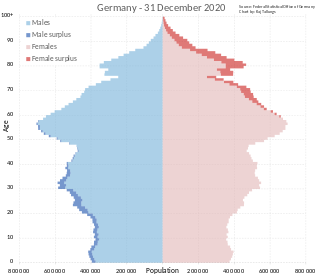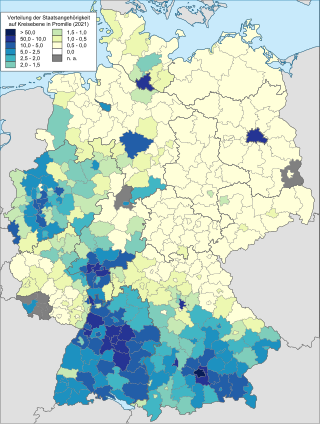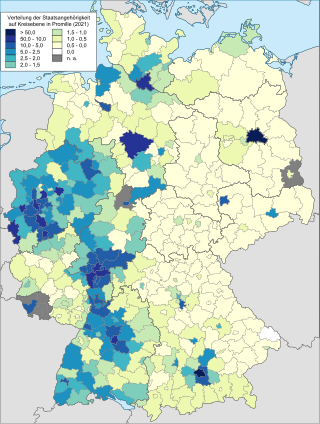
The demography of Germany is monitored by the Statistisches Bundesamt. According to the most recent data, Germany's population is 84,607,016 making it the most populous country in the European Union and the nineteenth-most populous country in the world. The total fertility rate was rated at 1.58 in 2021, significantly below the replacement rate of 2.1. For a long time Germany had one of the world's lowest fertility rates of around 1.3 to 1.4, however there has been a small increase in recent years. Due to the low birth rate Germany has recorded more deaths than births every year since 1972, which means 2021 was the 50th consecutive year the German population would have decreased without immigration. However, due to immigration the population has actually increased during the last half-century. In 2019 the number of people with a foreign background was 26%; this category includes foreigners, naturalized citizens, ethnic German repatriates from Eastern Europe and the children of all of the above.

Rhineland-Palatinate is a western state of Germany. It covers 19,846 km2 (7,663 sq mi) and has about 4.05 million residents. It is the ninth largest and sixth most populous of the sixteen states. Mainz is the capital and largest city. Other cities are Ludwigshafen am Rhein, Koblenz, Trier, Kaiserslautern, Worms and Neuwied. It is bordered by North Rhine-Westphalia, Saarland, Baden-Württemberg and Hesse and by France, Luxembourg and Belgium.

Saxony-Anhalt is a state of Germany, bordering the states of Brandenburg, Saxony, Thuringia and Lower Saxony. It covers an area of 20,451.7 square kilometres (7,896.4 sq mi) and has a population of 2.17 million inhabitants, making it the 8th-largest state in Germany by area and the 11th-largest by population. Its capital is Magdeburg and its largest city is Halle (Saale).

Baden-Württemberg, commonly shortened to BW or BaWü, is a German state in Southwest Germany, east of the Rhine, which forms the southern part of Germany's western border with France. With more than 11.07 million inhabitants as of 2019 across a total area of nearly 35,752 km2 (13,804 sq mi), it is the third-largest German state by both area and population. As a federated state, Baden-Württemberg is a partly-sovereign parliamentary republic. The largest city in Baden-Württemberg is the state capital of Stuttgart, followed by Mannheim and Karlsruhe. Other major cities are Freiburg im Breisgau, Heidelberg, Heilbronn, Pforzheim, Reutlingen, Tübingen, and Ulm.

Bremen, officially the Free Hanseatic City of Bremen, is the smallest and least populous of Germany's 16 states. It is informally called Land Bremen, although the term is sometimes used in official contexts. The state consists of the city of Bremen and its seaport exclave, Bremerhaven, surrounded by the larger state of Lower Saxony in northern Germany.

The Federal Statistical Office is a federal authority of Germany. It reports to the Federal Ministry of the Interior.

Pakistani-Germans refers to the community in Germany of Pakistani heritage or citizenship.

Croats in Germany refers to persons living in Germany who have total or partial Croatian ancestry. They form the sixth largest ethnic minority in Germany. In 2021, there were 434,610 Croats holding Croatian citizenship and living in Germany. Croatia's State Office for the Croats Abroad, Croatian embassy in Berlin and Croatian Catholic Missions estimated that there are more than 500,000 Croats and their descendants living in Germany.

There is a significant Russian population in Germany. The collapse of the Soviet Union in 1991 triggered mass immigration to the West, with Germany being the top destination, mostly for economic and ethnic reasons. Russians are the 3rd largest migrant group in Germany.

Belgium-Germany relations are the bilateral relations between Belgium and Germany. Both of these are neighbouring countries and share a common 204 kilometer long landborder. Both nations are members of the Council of Europe, European Union, NATO and the Eurozone.

Serbs in Germany refers to persons living in Germany who have total or partial Serbian ancestry. They form the seventh largest group of foreigners in Germany.

A national census in Germany was held every five years from 1875 to 1910. After the World Wars, only a few full population censuses have been held, the last in 1987. The most recent census, though not a national census, was the 2011 European Union census.
The Albanians in Germany refers to the Albanian migrants in Germany and their descendants. They mostly trace their origins to Albania, Kosovo and to a lesser extent to North Macedonia and other Albanian-speaking territories in the Balkan Peninsula. Their exact number is difficult to determine as some ethnic Albanians hold German, Macedonian, Serbian or another Former Yugoslavian citizenship.

In Germany, smoking is widespread and is subject to very few and lax regulations compared to other countries in Europe. Tobacco taxes in Germany are among the lowest in Europe. Germany ranks last on the Tobacco Control Scale and has sometimes been referred to as the "smoker's paradise" of Europe. According to German addiction researcher Heino Stöver, Germany has "[...] more cigarette vending machines than any other country in the world."

North Rhine-Westphalia (NRW) has always been Germany's powerhouse with the largest economy among the German states by GDP figures. If NRW were a sovereign country, it would have an economy comparable to that of Saudi Arabia in terms of nominal gross domestic product (GDP) as of 2014. Of all German states, most money from abroad is invested in NRW.
Jugendamt is a German and Austrian local agency set up to promote the welfare of children. Each district or district-free city has its own Jugendamt. Its structure is flat, with no centralised coordinating office. In Germany the youth offices were created during Weimar Republic by the Reich Youth Welfare Act of 1922, in force since 1924. Since the local organizations function independently there is no federal administrative supervision.

Germans of Spanish descent is any citizen or resident of Germany who is of Spanish ancestral origin. Between 1960-1973 up to 600,000 Spaniards emigrated to Germany.

In the narrow sense, Lebanese people in Germany include migrants from Lebanon living in Germany and their descendants, excluding Palestinians.

Eritreans in Germany are citizens and residents of Germany who were born in Eritrea or are of Eritrean descent. As of 2020, there are at least 75,735 Eritreans living in Germany.

The quality of Germany–Guinea relations has been subject to some fluctuations since bilateral relations were established in 1958. Due to its long history of cooperation in development policy, the Federal Republic of Germany enjoys a good reputation among the Guinean public.


















